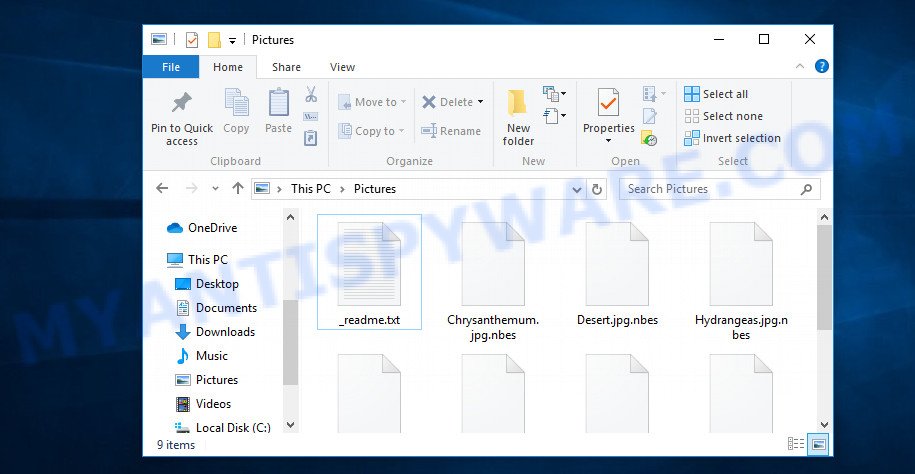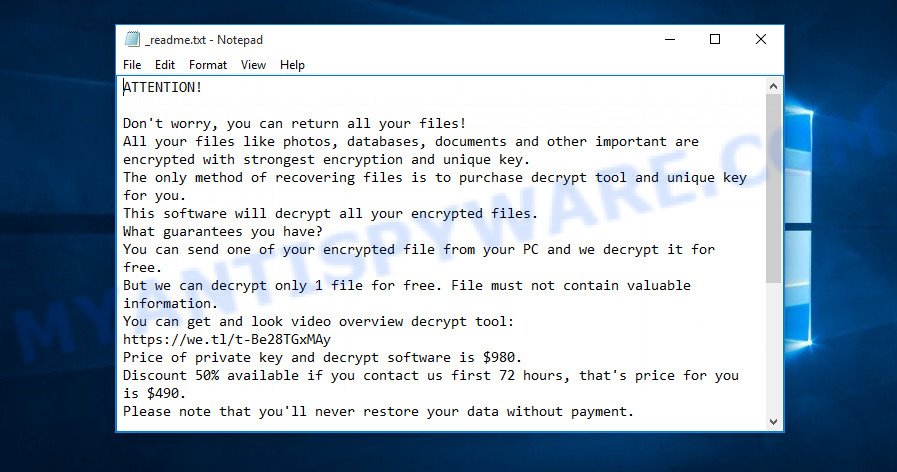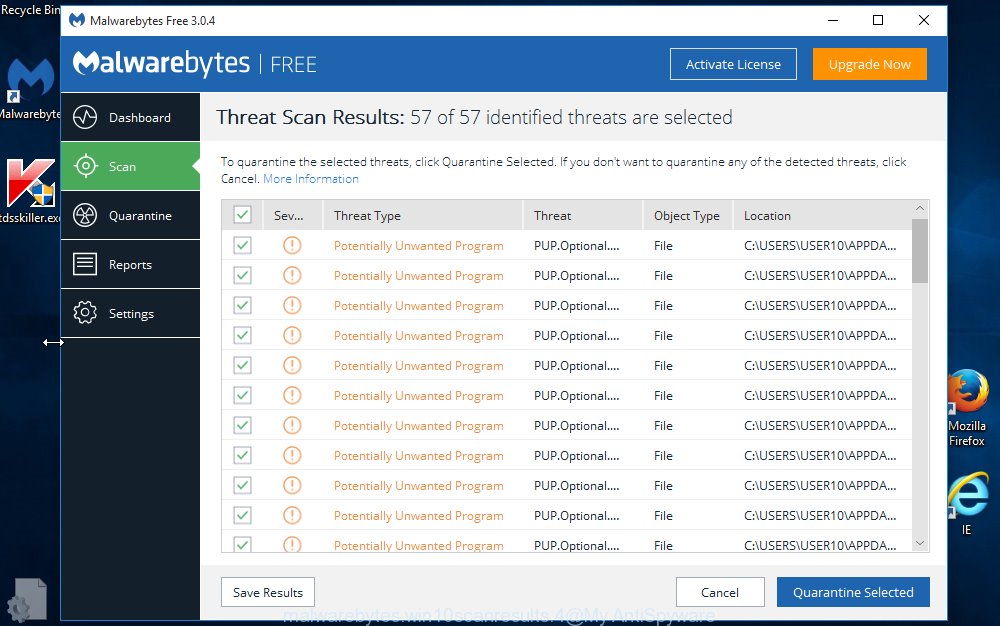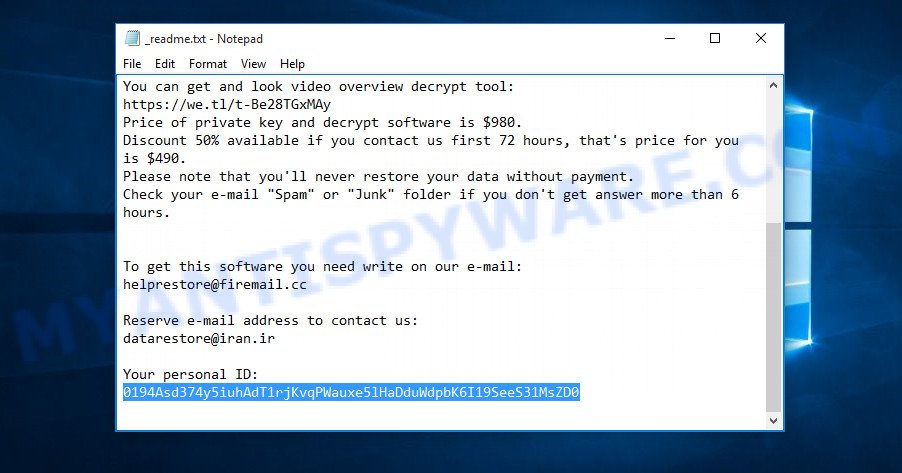.Nbes file extension is an extension that is used by the 194th version of the STOP ransomware. Like other ransomware, Nbes virus was created to encrypt the victim’s files, and then demand a ransom for decrypting them. Fortunately, a group of security researchers created a free decryptor. This decryptor can help virus victims decrypt .nbes files. In addition to the decryptor, there are several more methods, each of which can help restore the contents of encrypted files. Read more about this, as well as how to remove the virus and protect your computer from such ransomware below.

Screenshot of files encrypted by Nbes virus (‘.nbes’ file extension)
Nbes virus is new version of STOP (Djvu) ransomware. According to security researchers, this version is not much different from previous versions of STOP ransomware, such as Merl and Gesd, which were discovered last week. The ransomware virus is spread by websites offering to download freeware, key generators, activators, cracked games, torrents and so on.
Upon execution, Nbes creates a folder in the Windows system directory where it places a copy of itself and changes some Windows settings so that it starts up every time the computer is restarted or turned on. The virus collects information about the victim’s computer and then tries to establish a connection with its command server (C&C). If the connection has been established, then it sends information about the infected computer to the server, and in response receives the encryption key (the so-called ‘online key’) and additional commands and malware that must be executed on the victim’s computer. If the virus could not establish a connection with its command server, then it uses a fixed key (the so-called ‘offline key’).

Nbes virus encrypts files using a strong encryption algorithm and a key (‘offline key’ or ‘online key’, as described above). The virus tries to encrypt as many files as possible, for this it only encrypts the first 154kb of the contents of each file and thus significantly speeds up the encryption process. Nbes has the ability to encrypt files on all drives connected to the computer: internal hard drives, flash USB disks, network storage, and so on. It skips without encryption: files located in the Windows system directories, files with the extension .ini, .bat, .dll, .lnk, .sys and files with the name ‘_readme.txt’. The remaining files located on the victim’s computer can be encrypted. For example, the following file types may be the target of ransomware attack:
.p7c, .x3f, .mp4, .xlsx, .x3d, .sql, .odm, .txt, .dbf, .2bp, .zdb, .wire, .raw, .odb, .crw, .arch00, .rtf, .odt, .ai, .wbc, .menu, .sie, .sid, .upk, .xls, .png, .qdf, .wbk, .webp, .vdf, .xmmap, .xdl, .xls, .sidn, .docm, .wpd, .iwi, .lvl, .dcr, .yal, .wpw, .dwg, .xld, .itdb, .wb2, .xbplate, .yml, .js, .mef, .zif, .sidd, wallet, .syncdb, .t12, .x, .vpk, .slm, .sis, .desc, .ptx, .xlsb, .forge, .kf, .esm, .vfs0, .xlk, .vcf, .wpl, .arw, .epk, .hvpl, .m2, .ods, .py, .xar, .das, .wmo, .pptx, .7z, .erf, .xwp, .sum, .cer, .srf, .nrw, .m3u, .w3x, .wgz, .1st, .wsc, .mlx, .raf, .fpk, .rw2, .bc7, .sb, .webdoc, .zdc, .dng, .t13, .xmind, .kdc, .vtf, .wbmp, .wbd, .xy3, .hkx, .cr2, .css, .rar, .csv, .wps, .wps, .vpp_pc, .psk, .pptm, .bc6, .tax, .xdb, .ltx, .orf, .rofl, .mdbackup, .mpqge, .xll, .cdr, .ppt, .wdb, .ncf, .rim, .y, .xxx, .wp4, .wpe, .ybk, .wmv, .xml, .mov, .wp7, .zip, .bar, .bkf, .p12, .1, .db0, .3fr, .bsa, .srw, .z3d, .xx, .mrwref, .dba, .zi, .xpm, .r3d, .wpa, .fsh, .hkdb, .wpg, .ysp, .der, .wpt, .mdb, .pdd, .apk, .icxs, .xlsx, .psd, .wm, .mcmeta, .wdp, .ibank, .flv, .wmv, .cfr, .xlsm, .ntl, .qic, .rb, .wn, .lbf, .big, .wbz, .bik, .lrf, .wotreplay, .xf, .zip, .p7b, .dazip, .pem, .map, .dmp, .cas, .ws, .wp5, .litemod, .gdb, .3ds, .accdb, .tor, .wmf, .rgss3a, .mddata, .jpeg, .xlsm, .avi, .iwd, .m4a, .jpe, .pak, .blob, .fos, .re4, .wsd, .crt, .bkp, .wma, .xyw, .itm, .indd, .xbdoc
Nbes encrypts file-by-file. Each file that has been encrypted will be renamed, the .nbes extension will be added at the end of its name. Thus, it marks all encrypted files. In every directory where there is at least one encrypted file, the virus places a file named ‘_readme.txt’. The file contains a message from Nbes authors. An example of the contents of this file is given below.

Screenshot of the contents of ‘_readme.txt’ file (Nbes ransom note).
This message says that all files on the computer are encrypted and the only way to decrypt them is to buy a key and a decryptor from the authors of Nbes virus. That is, criminals demand a ransom for unlocking the victim’s files. The size of the ransom is $980, but if the victim is ready to pay the ransom within 72 hours, then its size is halved to $490. Attackers offer victims to verify that encrypted files can be decrypted. To do this, the victim must send them a small file to one of the email addresses specified in the ‘_readme.txt’ file. Of course, it is obvious that a single decrypted file cannot guarantee that after paying the ransom, the criminals will provide the victim with a working key and decryptor.
Threat Summary
| Name | Nbes |
| Type | Filecoder, Crypto virus, Crypto malware, File locker, Ransomware |
| Encrypted files extension | .nbes |
| Ransom note | _readme.txt |
| Contact | datarestorehelp@firemail.cc, datahelp@iran.ir |
| Ransom amount | $980,$490 in Bitcoins |
| Symptoms | Files encrypted with .nbes extension. Files won’t open. Windows Explorer displays a blank icon for the file type. Files named such as ‘_readme.txt’, or ‘_readme” in every folder with an encrypted file. |
| Distribution methods | Adware. Phishing Emails that is carefully developed to trick a victim into opening an attachment or clicking on a link that contains a malicious file. Exploit kits (cybercriminals use crypto virus packaged in an ‘exploit kit’ that can find a vulnerability in PDF reader, MS Windows operating system, Web-browser, Adobe Flash Player). Torrents websites. Social media, such as web-based instant messaging applications. Cracked games. |
| Removal | Nbes virus removal guide |
| Decryption | free Nbes Decryptor |
How to remove Nbes virus, Recover, Decrypt .nbes files
Security researchers confirm the words of the authors of Nbes virus. All files with the extension ‘.Nbes’ are encrypted and thus cannot be read and used. The only way to decrypt them is to use the key and the decryptor. Fortunately, there is some good news. As we already reported above, Nbes virus belongs to STOP ransomware family, which means that you can use the free decryptor created by Emsisoft to decrypt the encrypted files. Even if the decryptor does not help, there are some alternative ways that can help restore the contents of the encrypted files. To learn more about decrypting files, simply scroll down to section ‘How to decrypt .nbes files’. Read the entire manual carefully. To make it easier for you to follow the instructions, we recommend that you print it or open it on your smartphone.
How to remove Nbes ransomware virus
Finding and removing ransomware components manually is very difficult, so we recommend using free malware removal tools. Moreover, it is desirable to use not one, but several utilities. Even if it seems to you that there is no ransomware on the computer, it does not mean anything. The virus may start encrypting the files again the next time you turn on or restart the computer. You must be completely sure that Nbes has been removed, and also that there is no other malware on the computer. Below we provide a list of recommended tools with brief instructions.
Remove Nbes virus with Zemana Anti-Malware (ZAM)
In order to find and remove Nbes virus, we recommend using Zemana Anti-malware. It is a great malware removal tool from which you need to start removing the ransomware. Zemana has a simple interface, a powerful anti-malware engine that makes it easy to detect and remove malware of various kinds. This tool is suitable even for a user who has minimal knowledge of computers.
- Visit the following page to download the latest version of Zemana AntiMalware for Windows. Save it on your Windows desktop.
Zemana AntiMalware
164779 downloads
Author: Zemana Ltd
Category: Security tools
Update: July 16, 2019
- Once you have downloaded the installation file, make sure to double click on the Zemana.AntiMalware.Setup. This would start the Zemana Free installation on your PC.
- Select installation language and click ‘OK’ button.
- On the next screen ‘Setup Wizard’ simply click the ‘Next’ button and follow the prompts.

- Finally, once the installation is done, Zemana Free will start automatically. Else, if does not then double-click on the Zemana Free icon on your desktop.
- Now that you have successfully install Zemana Free, let’s see How to use Zemana AntiMalware to remove Nbes ransomware from your computer.
- After you have started the Zemana AntiMalware, you’ll see a window as on the image below, just press ‘Scan’ button . Zemana Anti-Malware program will scan through the whole PC system for Nbes ransomware virus.

- Now pay attention to the screen while Zemana Free scans your PC.

- When Zemana is done scanning your system, Zemana will display you the results. Once you have selected what you want to remove from your PC system click ‘Next’ button.

- Zemana may require a reboot PC in order to complete the Nbes virus removal procedure.
- If you want to permanently delete crypto virus from your system, then click ‘Quarantine’ icon, select all malicious software, adware software, potentially unwanted apps and other threats and press Delete.
- Restart your system to complete the crypto malware removal process.
Remove Nbes with MalwareBytes Anti Malware (MBAM)
If you’re having problems with Nbes removal, then download MalwareBytes. It’s free for home use, and detects and removes various malware that attacks your PC or degrades computer performance. MalwareBytes can remove ransomware, trojans, spyware, adware software, PUPs as well as malicious software, including worms and trojans.

- Download MalwareBytes Anti-Malware (MBAM) by clicking on the link below. Save it on your MS Windows desktop or in any other place.
Malwarebytes Anti-malware
327040 downloads
Author: Malwarebytes
Category: Security tools
Update: April 15, 2020
- Once the downloading process is complete, close all applications and windows on your PC system. Open a folder in which you saved it. Double-click on the icon that’s named mb3-setup.
- Further, press Next button and follow the prompts.
- Once install is complete, click the “Scan Now” button . MalwareBytes Free utility will start scanning the whole PC to find out Nbes related folders,files and registry keys. This task can take some time, so please be patient. During the scan MalwareBytes Free will detect threats exist on your personal computer.
- As the scanning ends, MalwareBytes will display a list of found malware. You may remove the found malware (move to Quarantine) by simply click “Quarantine Selected”. Once disinfection is done, you may be prompted to reboot your PC.
The following video offers a few simple steps on how to remove browser hijacker infections, adware and other malicious software with MalwareBytes Anti-Malware (MBAM).
Remove Nbes ransomware with Kaspersky virus removal tool
KVRT is a free removal utility that can be downloaded and run to remove ransomware, adware, malware, potentially unwanted programs, worms, spyware and other security threats from your personal computer. You can use this utility to scan for threats even if you have an antivirus or any other security program.
Download Kaspersky virus removal tool (KVRT) by clicking on the link below. Save it to your Desktop.
129228 downloads
Author: Kaspersky® lab
Category: Security tools
Update: March 5, 2018
When the downloading process is done, double-click on the Kaspersky virus removal tool icon. Once initialization process is done, you’ll see the KVRT screen as shown on the screen below.

Click Change Parameters and set a check near all your drives. Click OK to close the Parameters window. Next press Start scan button to search for Nbes ransomware virus and other known infections. Depending on your PC system, the scan may take anywhere from a few minutes to close to an hour. While the KVRT is scanning, you can see how many objects it has identified either as being malicious software.

When the scan get completed, you will be shown the list of all found threats on your system as shown in the following example.

Make sure all items have ‘checkmark’ and click on Continue to start a cleaning procedure.
How to decrypt .nbes files
As we already reported above, files with .nbes extension are files that have been encrypted by Nbes virus. Their contents will remain locked until decrypted using the decryptor and the key. Fortunately, there is a free decryptor that can decrypt .nbes files. Below we provide instructions on where to download and how to use this decryptor.

STOP Djvu decryptor
To decrypt .nbes files, use free STOP (nbes) decryptor
- Download STOP (nbes) decryptor from the following link.
STOP Djvu decryptor - Scroll down to ‘New Djvu ransomware’ section.
- Click the download link and save the decrypt_STOPDjvu.exe file to your desktop.
- Run decrypt_STOPDjvu.exe, read the license terms and instructions.
- On the ‘Decryptor’ tab, using the ‘Add a folder’ button, add the directory or disk where the encrypted files are located.
- Click the ‘Decrypt’ button.
Unfortunately, at the moment, this decryptor is able to decrypt only files encrypted with an offline key, as Emsisoft found a way to find this key. Files encrypted with an online key cannot yet be decrypted. The online key is unique to each infected computer, and at the moment there is no way to find this key. Of course, the authors of Nbes virus own this key, but we do not think that paying a ransom is the right way to decrypt .nbes files. In the case when the files are encrypted with an online key, there is a chance to restore the encrypted files using alternative methods, which are described below.
How to find out which key was used to encrypt files
Below we show two ways to help you determine what type of key was used to encrypt the files. This is very important, since the type of key determines whether it is possible to decrypt .nbes files for free. We recommend using the second method, as it is more accurate.
First of all, you can look at the personal ID that is given in the ‘_readme.txt’ file (ransom note).

Personal ID is highlighted here
Another way, look on disk ‘C’ for ‘SystemID\PersonalID.txt’ file. This is a file in which Nbes virus stores the Personal IDs used for encryption.
The ‘Personal ID’ is not a key, it is a set of characters by which everyone can find out which key was used to encrypt files. If the ID ends with ‘t1’, then the files are encrypted with an offline key. If the ID does not end with ‘t1’, then Nbes virus used an online key. If you could not understand which key was used to encrypt the files, then we can help you. Just write a request in the comments below.
What to do if STOP (nbes) decryptor says “Error: Unable to decrypt file with ID”
If the decryptor, when trying to decrypt .nbes files, displays a message ‘Error: Unable to decrypt file with ID’, skips files without decrypting them, then two cases are possible why this happens:
- files are encrypted with an ‘online key’, in this case, you need to use alternative methods to restore the contents of encrypted files;
- files are encrypted with an ‘offline key’, but the key itself has not yet been found by security researchers, in this case, you need to be patient and wait a while, in addition, you can also use alternative ways for recovering encrypted data;
How to restore .nbes files
As we mentioned above, in addition to using the free decryptor, there are several more methods for recovering encrypted files. These methods do not require the use of a decryptor and a key, and therefore are suitable for all cases when the virus used an online key, and for the case when the virus used an offline key. It is very important to check your computer for malware before you try to recover encrypted files. You must be 100% sure that Nbes virus is completely removed. To scan your computer for ransomware, use free malware removal tools.
Run ShadowExplorer to recover .nbes files
The Microsoft Windows has a feature called ‘Shadow Volume Copies’ that can help you to recover .nbes files encrypted by the ransomware. A small tool called ShadowExplorer will allow you to easily access the Shadow copies and restore the encrypted files to their original state. Unfortunately, the ransomware can delete these Shadow copies before it starts encrypting files. Therefore, if ShadowExplorer did not help you, then try another method, which is given below.
Visit the page linked below to download the latest version of ShadowExplorer for Windows. Save it on your Desktop.
439424 downloads
Author: ShadowExplorer.com
Category: Security tools
Update: September 15, 2019
After the downloading process is finished, open a directory in which you saved it. Right click to ShadowExplorer-0.9-portable and select Extract all. Follow the prompts. Next please open the ShadowExplorerPortable folder as shown below.

Double click ShadowExplorerPortable to start it. You will see the a window like the one below.

In top left corner, select a Drive where encrypted files are stored and a latest restore point as on the image below (1 – drive, 2 – restore point).

On right panel look for a file that you want to restore, right click to it and select Export as shown on the screen below.

Recover .nbes files with PhotoRec
The last chance to restore encrypted files to their original state is using data recovery tools. We recommend a program called PhotoRec. It has all the necessary functions to restore the contents of encrypted files. It helped many victims recover data when it seemed like there was no more hope.
Download PhotoRec on your Windows Desktop by clicking on the link below.
After the downloading process is done, open a directory in which you saved it. Right click to testdisk-7.0.win and select Extract all. Follow the prompts. Next please open the testdisk-7.0 folder as shown on the screen below.

Double click on qphotorec_win to run PhotoRec for Windows. It will open a screen as displayed on the image below.

Choose a drive to recover like below.

You will see a list of available partitions. Select a partition that holds encrypted personal files like below.

Click File Formats button and specify file types to recover. You can to enable or disable the restore of certain file types. When this is finished, press OK button.

Next, click Browse button to select where recovered photos, documents and music should be written, then click Search.

Count of restored files is updated in real time. All restored files are written in a folder that you have chosen on the previous step. You can to access the files even if the restore process is not finished.
When the restore is finished, click on Quit button. Next, open the directory where restored photos, documents and music are stored. You will see a contents like below.

All restored files are written in recup_dir.1, recup_dir.2 … sub-directories. If you are searching for a specific file, then you can to sort your recovered files by extension and/or date/time.
How to protect your computer from Nbes crypto malware
Most antivirus applications already have built-in protection system against the ransomware. Therefore, if your computer does not have an antivirus program, make sure you install it. As an extra protection, run the HitmanPro.Alert. All-in-all, HitmanPro.Alert is a fantastic tool to protect your system from any ransomware. If ransomware is detected, then HitmanPro.Alert automatically neutralizes malware and restores the encrypted files. It is compatible with all versions of Windows operating system from Windows XP to Windows 10.
Visit the following page to download the latest version of HitmanPro Alert for Windows. Save it on your MS Windows desktop or in any other place.
When downloading is complete, open the file location. You will see an icon like below.

Double click the HitmanPro.Alert desktop icon. Once the utility is started, you’ll be shown a window where you can select a level of protection, as displayed on the screen below.

Now click the Install button to activate the protection.
To sum up
This guide was created to help all victims of Nbes ransomware virus. We tried to give answers to the following questions: how to remove ransomware; how to decrypt .nbes files; how to recover files, if STOP (nbes) decryptor does not help; what is an online key and what is an offline key. We hope that the information presented in this manual has helped you.
If you have questions, then write to us, leaving a comment below. If you need more help with Nbes related issues, go to here.



























0194Asd374y5iuhldgd1mwJ5HIiVix5okAi1ry48cOZ2f58OM id provide me to hacker so plz sagest me.
The “0194Asd374y5iuhldgd1mwJ5HIiVix5okAi1ry48cOZ2f58OM” ID is related to an online key, so files cannot be decrypted. Try to restore the contents of encrypted files using the following guide: How to recover ransomware encrypted files.
0194Asd374y5iuhldUPdaGQobCidh4jPcMN8RQsWbEkpeYrR1baR3Jg8P id provide me to hacker so plz suggest me
The “0194Asd374y5iuhldUPdaGQobCidh4jPcMN8RQsWbEkpeYrR1baR3Jg8P” ID is related to an online key, so files cannot be decrypted. Try to restore the contents of encrypted files using the steps linked below: How to recover encrypted files.